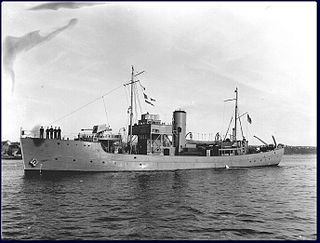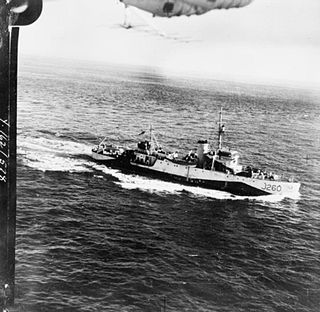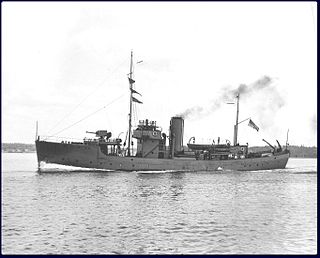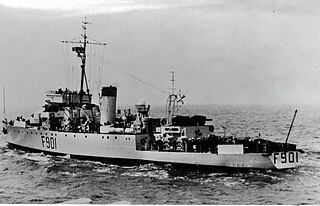 W
WThe Bangor-class minesweepers were a class of warships operated by the Royal Navy (RN), Royal Canadian Navy (RCN), Imperial Japanese Navy (IJN), and Royal Indian Navy (RIN) during the Second World War.
 W
WThe Fundy-class minesweepers were a class of four minesweepers operated by the Royal Canadian Navy during the Second World War. All four ships entered service in 1938 and the class were discarded in 1945, sold for mercantile service. Three ended up sold to Chinese interests, while one remained active in Canada until 1987.
 W
WThe Isles-class trawlers were a class of naval trawler used by the Royal Navy, Royal Canadian Navy and Royal New Zealand Navy during World War II.
 W
WHMS Baffin was an Isles-class trawler of the Royal Navy. Constructed in Canada for the Royal Navy, the trawler was one of eight loaned to the Royal Canadian Navy during the Second World War. The vessel was mostly engaged in minesweeping duties out of Halifax, Nova Scotia. Following the war, Baffin was returned to the Royal Navy. The vessel was then sold into mercantile service. The vessel was broken up in 1983.
 W
WHMCS Burlington was a Bangor-class minesweeper constructed for the Royal Canadian Navy during the Second World War. The minesweeper entered service in 1941 and took part in the Battle of the Atlantic and the Battle of the St. Lawrence as a convoy escort. The ship was decommissioned in 1945 and sold in 1946. The vessel was broken up for scrap in 1946.
 W
WHMCS Comox was a Fundy-class minesweeper that served in the Royal Canadian Navy from 1938–1945. She served during the Second World War as a local patrol craft for Esquimalt, British Columbia before transferring to Halifax, Nova Scotia performing general minesweeping duties. After the war she sold for mercantile service and converted to a tugboat named Sung Ming. The ship's registry was deleted in 1993.
 W
WHMCS Digby was a Bangor-class minesweeper that served in the Royal Canadian Navy during the Second World War. She saw action in the Battle of the Atlantic and the Battle of the St. Lawrence. After the war she was supposed to be transferred to the Royal Canadian Mounted Police but that was cancelled and instead was recommissioned into the Royal Canadian Navy, serving until 1956.
 W
WHMCS Drummondville was a Bangor-class minesweeper that served with the Royal Canadian Navy during the Second World War. She saw action primarily in the Battle of the Atlantic. Entering service in 1941, she was sold for mercantile service after the war. In 1963, as Fort Albany, the ship was involved in a collision near Sorel, Quebec and sank. The ship was later raised and broken up.
 W
WHMCS Esquimalt was a Bangor-class minesweeper that served in the Royal Canadian Navy during the Second World War. She saw service in the Battle of the Atlantic and in the Battle of the St. Lawrence. She was sunk in 1945, the last Canadian warship to suffer that fate. She was named for Esquimalt, British Columbia.
 W
WHMCS Fort Frances was an Algerine-class minesweeper that served in the Royal Canadian Navy during the Second World War. She served primarily as a coastal convoy escort in the Battle of the Atlantic. The ship was named for Fort Frances, a town in northwestern Ontario. Following the war, the vessel was transferred to the Department of Mines and Technical Surveys and used for hydrographic and oceanographic survey. The vessel was discarded in 1974 and broken up for scrap.
 W
WHMCS Fundy was a Fundy-class minesweeper that served in the Royal Canadian Navy from 1938 to 1945. The minesweeper was the first warship built for Canada since 1918. She saw service in the Atlantic Ocean during the Second World War. The vessel was named for the Bay of Fundy. After the war she had an extensive civilian career.
 W
WHMCS Gaspé was a Fundy-class minesweeper that served in the Royal Canadian Navy from 1938 to 1945. She saw service during the Second World War as part of the local defence of Halifax, Nova Scotia. She was named for Gaspé Bay in Quebec. Following the war the ship was sold for mercantile use, becoming the tugboat Sung Li. The ship's registry was deleted in 1993.
 W
WHMCS Goderich was a Bangor-class minesweeper constructed for the Royal Canadian Navy during the Second World War. Entering service in 1941, Goderich spent the entire war as a local convoy escort based out of Halifax, Nova Scotia. The vessel was decommissioned in 1945 and placed in reserve. Reacquired during the Korean War, the vessel was modernized but never re-entered service and was sold for scrap and broken up in 1959.
 W
WThe Llewellyn-class minesweepers were a series of ten coastal minesweepers constructed for the Royal Canadian Navy during the Second World War. Based on the Admiralty type MMS-class minesweeper, the Llewellyn class were constructed of wood and used for the removal of magnetic influence mines. Two were built in Quebec, with the eight constructed on the Western Coast of Canada. Mostly used as guard ships during the war, only three of the ten remained in Royal Canadian Navy service following the war, with the last being discarded in 1957. Following naval service, vessels of the class ended up in commercial service, with some becoming fishing vessels, cargo ships and one a floating restaurant. Six of the ten ships were lost in commercial service.
 W
WHMCS Nootka was a Fundy-class minesweeper that served in the Royal Canadian Navy from 1938–1945. She saw service during the Second World War as a local minesweeper working out of Halifax, Nova Scotia. She was named for Nootka Sound. In 1943 she was renamed HMCS Nanoose to allow the unit name Nootka to be used by the destroyer HMCS Nootka. Following the war the ship was sold for mercantile use, becoming the tugboat Sung Ling. The ship's registry was deleted in 1993.
 W
WAfter the fall of Norway to Nazi Germany on 10 June 1940, the Norwegian whale factory ship Suderøy and her whale catchers, Suderøy IV (J03), Suderøy V (J04), Suderøy VI (J05) and Star XVI were ordered to sail to Halifax from Hampton Roads, where they had taken refuge. In June 1940, at Halifax, Suderøy IV, V and VI were chartered from the Norwegian government in exile by the Royal Canadian Navy, converted and commissioned as minesweepers.
 W
WHMCS Thunder was a Bangor-class minesweeper constructed for the Royal Canadian Navy during the Second World War. The minesweeper entered service in 1941 and took part in the Battle of the Atlantic and the invasion of Normandy. Following the war Thunder was sold for scrap and broken up.
 W
WHMCS Wallaceburg was an Algerine-class minesweeper that served in the Royal Canadian Navy during the Second World War as a convoy escort during the Battle of the Atlantic. After the war the vessel was used from 1950 to 1959 for cadet training. In 1959 she was sold to the Belgian Navy and served until 1969 as F901 Georges Lecointe, the second ship to be named after Georges Lecointe.
 W
WHMCS Winnipeg was an Algerine-class minesweeper that served in the Royal Canadian Navy during the Second World War. Used primarily as a convoy escort, the vessel served in the Battle of the Atlantic. Following the war she placed in reserve before being sold to Belgium and renamed A.F. Dufour. She served with the Belgian Navy until 1966.